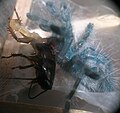| Antilles pinktoe tarantula | |
|---|---|
 | |
| Scientific classification | |
| Kingdom: | Animalia |
| Phylum: | Arthropoda |
| Subphylum: | Chelicerata |
| Class: | Arachnida |
| Order: | Araneae |
| Infraorder: | Mygalomorphae |
| Family: | Theraphosidae |
| Genus: | Caribena |
| Species: | C. versicolor |
| Binomial name | |
| Caribena versicolor (Walckenaer, 1837) [2] | |
| Synonyms [2] [3] | |
| |
The Antilles pinktoe tarantula (Caribena versicolor), also known as the Martinique red tree spider or the Martinique pinktoe, is a species of spider belonging to the family Theraphosidae, the tarantulas. This species was previously placed in the genus Avicularia , C. versicolor is native to Martinique in the Caribbean Sea. [3]
Contents
Antilles pinktoe tarantulas are arboreal (tree-dwelling). They spin elaborate funnel webs in which they spend most of their time.
Spiderlings of C. versicolor are bright blue with a black tree trunk pattern on the abdomen. As they grow, they gradually lose their blue coloration; the carapace turns green, the abdomen red, and the legs turn green with pink tarsi and a covering of purple hairs. Males usually are slightly more brightly colored than females. As in most tarantula species, males do not grow as large as females, and their abdomens are smaller than those of females, even in proportion to their size.


